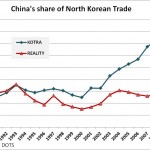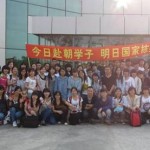UPDATE 1 (2012-6-18): According to Yonhap:
South Korean firms and China’s Jilin Province agreed to engage in joint venture projects worth 3.9 trillion won (US$3.4 billion), a local business organization said Monday.
Under the memorandum of understanding reached in Seoul, 48 South Korean companies and 48 Chinese regional government agencies and businesses will form partnerships to move forward on various business projects, the Korea Chamber of Commerce and Industry (KCCI) said.
The two sides will engage in such areas as agriculture, construction, energy, distribution and tourism, South Korea’s largest private economic organization said.
Lotte Group, the Korea Software Enterprise Association and HS Machinery Co. have expressed interest in business tie-ups with Jilin, which is located in northwestern China and includes Yanbian Korean Autonomous Prefecture. The province also borders North Korea to the south.
The KCCI said Jilin is one of China’ main heavy industrial hubs with average annual growth in the past three years reaching 13 percent. Such growth promises considerable business opportunities for South Korean companies wanting to diversify into emerging markets.
ORIGINAL POST (2012-5-3): According to China Daily:
The Chinese government announced Wednesday that it has approved the establishment of an international cooperative demonstration zone in Northeast China’s Jilin province to boost cross-border cooperation in the region.
In a document posted on the central government’s official website, the State Council said the zone is expected to expand investment cooperation in northeast Asian regions.
Located in the port city of Hunchun, the demonstration zone will cover 90 square km and include an international industrial cooperation zone, a border trade cooperation zone and economic cooperation zones — one between China and the Democratic People’s Republic of Korea (DPRK) and another between China and Russia, it said.
The demonstration zone will focus on the development of local manufacturing and processing industries, including those for auto parts, agricultural and animal products, seafood, new materials, medicines, textiles and garments, the document said.
The Tumen River in Hunchun straddles the borders of China, Russia and the DPRK. In 1992, China, Russia, the DPRK, the Republic of Korea (ROK) and Mongolia launched a joint development project in the Tumen River area, a move made to strengthen regional cooperation in the area.
The State Council has called for more efforts to boost the construction of Sino-DPRK and Sino-Russia international transit corridors and promote cross-border economic cooperation between China and the two countries.
More supporting policies, including fiscal and taxation support, will be implemented to encourage the development of new energy, new material equipment manufacturing and other projects in the demonstration zone, according to the State Council.
The construction of the demonstration zone will also make border regions more open to the outside and strengthen the social and economic development of local areas, the document said.
And according to the Daily NK:
The authorities in China’s Jilin Province are investing billions of Yuan in multiple projects along the Sino-North Korean border. The construction is concentrated in areas adjacent to major North Korean border towns in the mountainous region, giving it the hypothetical potential to provide massive opportunities for future Sino-North Korean economic growth.
According to Jilin Shinmun and other local media outlets, the high-speed train, which will allow travel from Hunchun to Changchun in two hours at speeds of up to 250kph, is under construction at a predicted cost of 37.7 billion Yuan.
Jilin Province is also planning a “five border region highway” in its 12th Five-Year Plan from 2011 to 2015. The Changchun to Hunchun leg is already open, while legs from Changchun to Huyinan, Songjangheo to Changbai, Changchun to Mt. Baekdu to Yanji, Changchun to Linjiang and Changchun to Jibian are under construction with the typical degree of Chinese speed. Among these locations, Changbai, Linjiang and Jibian all face major North Korean towns (Hyesan (Yangkang Province), Chungkang (Jagang Province) and Manpo (Jagang Province).
The province is also putting weight behind railway construction travelling towards North Korea; from Nanpin to nearby Musan (in North Hamkyung Province), Kayisan to Sambong (in North Hamkyung Province) and Changbai to Hyesan.
When all the construction is complete, there will be a bridgehead connecting the Tumen to the Yalu and linking all North Korea’s major cities with the Chinese economic miracle. If trade and cooperation between the two countries grows more active than it is now, the newly built highways and railways will form the core pathway for commercial distribution.
However, there are also major concerns with the plan. First and foremost, defection will become more difficult when the new developments are complete. The regions where highways and railways are now appearing have long been major defection routes or hiding places for new defectors.
In particular, a warning device installed by Jilin police in border villages, while an improvement in terms of public security, can also be used to report North Korean defectors to the authorities. The device, known as the ‘BF-01’, has been installed in 6,000 homes along the border at a cost of 5 million Yuan, connecting them with public security offices in an emergency. When pressed, names, addresses and the sound from the scene is transmitted to the local police station, border guards and neighbors.
“Regardless of whether North Korea conducts a nuclear test, it seems that North Korea and China are developing the northeastern region,” Shin Jong Ho, a research fellow with the Center for Northeastern Asian & Inter-Korean Affairs, part of the Gyeonggi Research Institute, commented. “In the future, if cooperation between North Korea and China gets better then these transportation routes will be very useful.”
Read the full stories here:
China approves int’l border cooperation zone
China Daily (Xinhua)
2012-4-25
Border Region Getting Huge Boost
Daily NK
Park Seong Guk
2012-5-3


